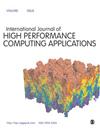Compressed basis GMRES on high-performance graphics processing units
IF 2.5
3区 计算机科学
Q2 COMPUTER SCIENCE, HARDWARE & ARCHITECTURE
International Journal of High Performance Computing Applications
Pub Date : 2022-08-05
DOI:10.1177/10943420221115140
引用次数: 1
Abstract
Krylov methods provide a fast and highly parallel numerical tool for the iterative solution of many large-scale sparse linear systems. To a large extent, the performance of practical realizations of these methods is constrained by the communication bandwidth in current computer architectures, motivating the investigation of sophisticated techniques to avoid, reduce, and/or hide the message-passing costs (in distributed platforms) and the memory accesses (in all architectures). This article leverages Ginkgo’s memory accessor in order to integrate a communication-reduction strategy into the (Krylov) GMRES solver that decouples the storage format (i.e., the data representation in memory) of the orthogonal basis from the arithmetic precision that is employed during the operations with that basis. Given that the execution time of the GMRES solver is largely determined by the memory accesses, the cost of the datatype transforms can be mostly hidden, resulting in the acceleration of the iterative step via a decrease in the volume of bits being retrieved from memory. Together with the special properties of the orthonormal basis (whose elements are all bounded by 1), this paves the road toward the aggressive customization of the storage format, which includes some floating-point as well as fixed-point formats with mild impact on the convergence of the iterative process. We develop a high-performance implementation of the “compressed basis GMRES” solver in the Ginkgo sparse linear algebra library using a large set of test problems from the SuiteSparse Matrix Collection. We demonstrate robustness and performance advantages on a modern NVIDIA V100 graphics processing unit (GPU) of up to 50% over the standard GMRES solver that stores all data in IEEE double-precision.在高性能图形处理单元上压缩基础GMRES
Krylov方法为许多大型稀疏线性系统的迭代求解提供了一种快速、高度并行的数值工具。在很大程度上,这些方法的实际实现的性能受到当前计算机体系结构中通信带宽的限制,这促使人们研究复杂的技术,以避免、减少和/或隐藏消息传递成本(在分布式平台中)和内存访问(在所有体系结构中)。本文利用Ginkgo的内存访问器,将通信减少策略集成到(Krylov)GMRES求解器中,该求解器将正交基的存储格式(即内存中的数据表示)与该基的运算过程中使用的算术精度解耦。假设GMRES解算器的执行时间在很大程度上由存储器访问决定,数据类型转换的成本可能大部分被隐藏,从而通过减少从存储器检索的比特数量来加速迭代步骤。再加上正交基的特殊性质(其元素均以1为界),这为积极定制存储格式铺平了道路,存储格式包括一些浮点和定点格式,对迭代过程的收敛性有轻微影响。我们使用SuiteParse矩阵集合中的大量测试问题,在Ginkgo稀疏线性代数库中开发了“压缩基GMRES”求解器的高性能实现。与以IEEE双精度存储所有数据的标准GMRES解算器相比,我们在现代NVIDIA V100图形处理单元(GPU)上展示了高达50%的稳健性和性能优势。
本文章由计算机程序翻译,如有差异,请以英文原文为准。
求助全文
约1分钟内获得全文
求助全文
来源期刊
CiteScore
6.10
自引率
6.50%
发文量
32
审稿时长
>12 weeks
期刊介绍:
With ever increasing pressure for health services in all countries to meet rising demands, improve their quality and efficiency, and to be more accountable; the need for rigorous research and policy analysis has never been greater. The Journal of Health Services Research & Policy presents the latest scientific research, insightful overviews and reflections on underlying issues, and innovative, thought provoking contributions from leading academics and policy-makers. It provides ideas and hope for solving dilemmas that confront all countries.

 求助内容:
求助内容: 应助结果提醒方式:
应助结果提醒方式:


